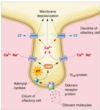Lecture 10- Gustation and Olfaction, Taste and Smell Flashcards
(64 cards)
What is gustation?
-the process of eating
What is taste?
-not flavour! -it is the sensation detected by the mouth -quite crude
What is flavour?
-the sensory experience of food and drink
What does flavour contain?
-dominated by smell and taste -can include texture,appearance, temperature, pain (chilli), fat
How does appearance come into flavour?
-we eat with our eyes, appearance is very important to what the food tastes like for us
How does temperature come into flavour?
-if something is the wrong temperature then its flavour is wrong (like warm coke)
How does pain come into flavour?
chilli= humans really like it, active ingredient is capsaicin, neurotoxin= kills some sensory neurons and activates pain fibres and those sensitive to chemical burn
How does fat come into flavour?
-if not the right level of fat then food lacks interest, fat sensitive receptors in mouth that feed into the gustatory pathways
What are the 5 well defined sensory stimuli that taste is confined to? And the 2 less well defined?
-sweet, sour, salty, bitter, umami -less well defined: metallic, piquant or pungent
How many odours can humans detect and how many can we discriminate?
-more than 2000 -each of the odours has a specialised receptor -sense of smell is more subtle -but can only discriminate 5 odours, can get interesting interesting combinations but pair wise they can only discriminate 5
What contributes to flavour?
-both olfaction and taste
What does food in the mouth activate?
-activates taste (gustatory) afferents (running towards the brain -activates olfactory afferents as everything that is in the mouth has access to the nasal cavity (olfaction via diffusion of volatile odours into nasal cavity)
What separates the nasal cavity and the mouth?
-the palate -if have a blocked nose= that is why we can’t taste as well, need olfactory input too
Where are the fatty acid receptors located?
-around the soft palate, on the side of the mouth, all the other receptors are on the tongue
Does the tongue have specialised part that respond to one flavour?
-sort of -has regions that will respond more to one -we have different bits sensitive to one in particular but practically any part of the tongue can respond to any part of the tongue -typically if you touch sth with the tip of your tongue then it will determine sweet as the predominant taste
Where on the tongue is sweet located and why is it important to detect?
-tip of the tongue -important as it indicates presence of sugars= energy
What are the two flavours that all animals seek out?
-sweet and salty
Where on the tongue is salty located and why is it important to detect?
-forward edges of the tongue -important as salt is an essential part of the diet and we need it for proper function of muscles and the nervous system
Where on the tongue is bitter located and why is it important to detect?
-back edges and back centre of the tongue -bitter= indication that something is toxic, plants produce bitter flavour to warn predators not to eat
Where on the tongue is umami located and why is it important to detect?
-not clear -it is the amino acid glutamate -essential amino acid, used in the brain, it enhances all the other tastes and the olfactory -when we get given unknown meet= it has acids activating umami = that is part of teh chicken flavour -so we say it tastes like chicken -can add umami= can make vegetarian food tastes like meat
Where on the tongue is sour located and why is it important to detect?
-central edges of the tongue -sour=if sth is sour it is intermediate (of bitter= then you want to spit it out) with sour also indicates that food probs not good for you -acid indicates it is starting to ferment= rotting
What are the taste sensitive structures called?
papillae, they are the little ridges on the tongue
What is a taste bud?
-collection of taste-receptive cells -selection of different taste cells
How many taste buds does a person usually have?
2000-5000














